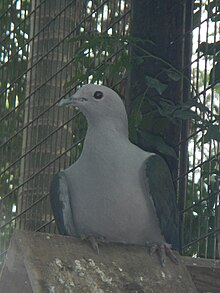Grey imperial pigeon
| Grey imperial pigeon | |
|---|---|

| |
| ssp. pickeringii | |
| Scientific classification | |
| Domain: | Eukaryota |
| Kingdom: | Animalia |
| Phylum: | Chordata |
| Class: | Aves |
| Order: | Columbiformes |
| Family: | Columbidae |
| Genus: | Ducula |
| Species: | D. pickeringii
|
| Binomial name | |
| Ducula pickeringii (Cassin, 1855)
| |
The grey imperial pigeon (Ducula pickeringii) is a species of bird in the family Columbidae. It is found in the Sulu Archipelago, Miangas and Talaud Islands. It is a small island specialist where its natural habitats are tropical moist lowland forests and plantations. It is threatened by habitat loss.
Description and taxonomy
[edit]eBird describes the bird as "Large pigeon with an elegant, silky appearance. Smooth, pearly gray below with dark gray wings, back, and tail (the first two can appear iridescent greenish in good light). Also note faint white eye-ring. Can be confused with Green Imperial-Pigeon, but Gray is much duller- and darker-winged. An inhabitant of forested offshore islands, where it is typically encountered singly or in pairs up in the canopy. Song is a low, booming 'coOOOooouh'."[2]
Subspecies
[edit]Three subspecies are recognized:
- D. p..pickeringii – Found on islets off of North and Northeast Borneo and the islets in the Sulu Sea from Balabac, Cagayancillo and Sulu Island.
- D. p. langhornei – Found on West Bolod, East Bolod and Loran; paler with a more defined white ring around eye.
- D. p. palmasensis – Found on Miangas and Talaud Islands ; paler and less pink on underparts
Behaviour and ecology
[edit]It has been noted feeding on fruits of figs and Cananga trees.Usually seen singly or in pairs. It sometimes associates with Green imperial pigeon and Pied imperial pigeon. Not much is known about its breeding habits but a female with a developing egg inside was taken in January in Miangas. Juveniles collected in July in Sabah.[3]
Habitat and conservation status
[edit]
Its natural habitats at tropical moist lowland and primary and secondary forest and cultivated areas with trees. Little is known about its movements. It is reportedly resident on some northern Bornean islands, but certainly moves between Philippine islands, and varied in abundance from 1995 to 1997 on Karakelang, Indonesia. Like other small-island specialists, it presumably wanders in search of food.
The IUCN Red List has assessed this bird as vulnerable with the population estimated at 2,500 to 10,000 mature individuals. Its main threat is habitat destruction through both legal and Illegal logging, conversion into farmland and urban development for tourism. Its large size makes it a target of hunters both for food and as a pet.
It occurs in a few protected areas like the Turtle Islands National Park, Tunku Abdul Rahman National Park, Maratuas and Pulau Mantanani Bird Sanctuary and Rasa Island where it benefits from the protection of the Philippine cockatoo.
Conservation actions proposed are survey in suitable habitat in order to calculate density estimates, better understand movements and ecology and calculate remaining habitat to refine the population estimate. Propose sites/islands supporting key populations for establishment as strict protected areas. Eradicate macaques and black rats from protected islands.Devise and initiate conservation awareness campaigns to control hunting and curb deforestation on key islands. Seek ban on trade in Imperial pigeons. Review taxonomic status of two subspecies (pickeringii and langhornei).[4]
References
[edit]- ^ BirdLife International (2016). "Ducula pickeringii". IUCN Red List of Threatened Species. 2016: e.T22691710A93322157. doi:10.2305/IUCN.UK.2016-3.RLTS.T22691710A93322157.en. Retrieved 12 November 2021.
- ^ "Grey Imperial Pigeon". Ebird.
- ^ Baptista, Luis F.; Trail, Pepper W.; Horblit, H. M.; Boesman, Peter F. D.; Garcia, Ernest (2020). "Gray Imperial-Pigeon (Ducula pickeringii), version 1.0". Birds of the World. doi:10.2173/bow.gryimp1.01species_shared.bow.project_name. ISSN 2771-3105.
- ^ International), BirdLife International (BirdLife (2016-10-01). "IUCN Red List of Threatened Species: Ducula pickeringii". IUCN Red List of Threatened Species. Retrieved 2021-09-17.
External links
[edit]

